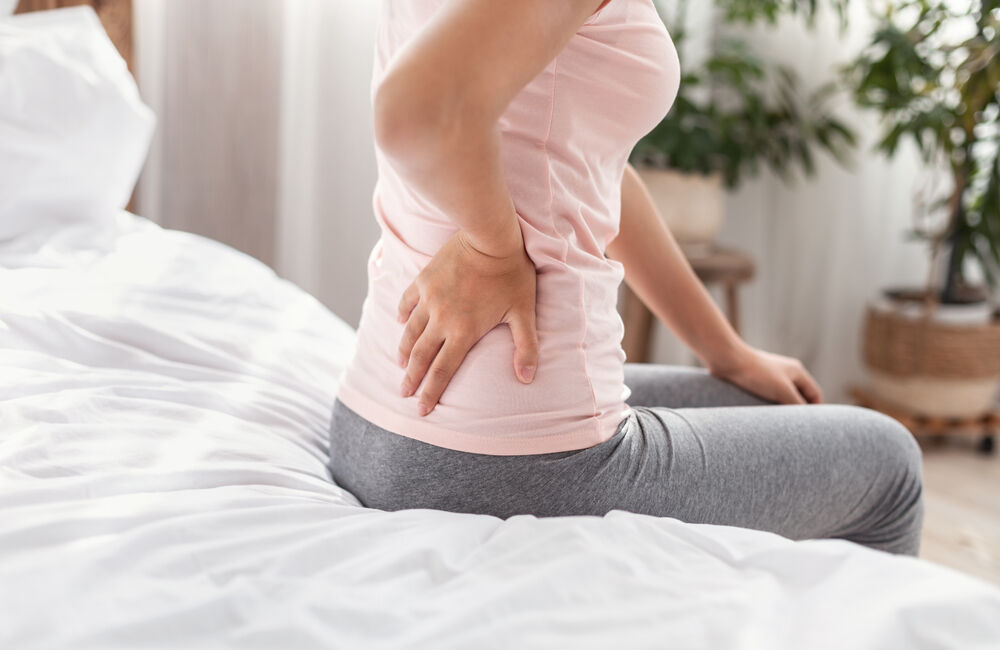Struggling to fall asleep and stay asleep because of lower back pain?
You're not alone. According to the CDC, some 16 million American adults (8% of all adults) deal with persistent or chronic back pain. Lower lumbar issues especially can turn what should be a peaceful night's rest into a toss-and-turn ordeal. If that weren't enough, the very act of sleeping in an improper position can amplify your back woes, creating a vicious cycle of pain and restless nights.
Put simply, lower back pain isn’t just an inconvenience—it's a formidable barrier to achieving the restorative rest your body needs.
Ready to break the cycle?
Here’s how to sleep with lower back pain.
Alleviate Pain While You Dream with Proper Sleeping Positions
Your sleeping position is incredibly important to tackling lower back pain. Although it can be a trial-and-error process, some positions may offer more relief than others.
Side sleeping with a slight knee bend is often considered the best for reducing lumbar strain. You can make it even more comfortable by placing a small ergonomic pillow between your knees to maintain proper spinal alignment. Or, you can use a full-length body pillow to take pressure off the spine and shoulders.
If you're a back sleeper, slip a firm pillow under your knees. This simple adjustment relaxes your back muscles and preserves the natural curve of your lower spine.
Are you a stomach sleeper?
Unfortunately, you may need to re-learn how you sleep by shifting to a side or back-only position. Sleeping on your stomach might not cause issues in your younger years, but as you age, it becomes increasingly detrimental to your spine and can worsen lower back pain. While shifting to a different sleep position may take some conditioning, your back will thank you for it.
Similarly, there are other poor sleep habits that anyone with chronic back pain should avoid. This includes sleeping:
- In a fetal position
- With straight legs
- With crossed legs
- With arms above your head
Invest in a Quality Mattress
The type of mattress you use will also play a pivotal role in managing lower back pain and achieving deep and restful sleep. Medium firm mattresses with targeted lumbar support is generally recommended by chiropractors. However, mattress suitability can be as unique as you are—there's no one-size-fits-all solution.
As you search for the best mattress, consider these factors:
- Spinal alignment – Your mattress should respect the natural curvature of your spine, whether you sleep on your back or your side.
- Firmness levels – Steer clear of mattresses that are too soft or too hard. Either extreme could exacerbate your lower back issues.
- Materials – While some people recommend memory foam mattresses, hybrid or innerspring models offering zoned lumbar support can actually be superior choices for a person suffering from chronic back pain.
Fortunately, many mattress suppliers offer sleep trial periods. For instance, at Mancini’s Sleepworld, we offer an unbeatable 120-night trial.
Remember, it can take up to 14 days to settle into a new sleep surface, so give it some time. However, if you find that the mattress is not alleviating your low back pain, don't hesitate to return it and try another option.
Treat Your Back
While the best sleeping position and an ideal mattress can go a long way, ideally, you need to address lower back pain at the source.
Lower back pain can have various causes, and while something like a slipped disk may require surgical intervention, many other issues can be alleviated through less invasive means, such as:
- Light exercise – A moderate routine focusing on core strengthening and flexibility can often reduce chronic back pain and improve sleep.
- Losing weight – Shedding excess weight can relieve pressure on your lower back, making it easier to find a comfortable sleeping position. Consider a balanced diet and regular exercise as effective strategies for weight loss and improved sleep quality.
- Stretching and yoga – Incorporating regular stretching or yoga sessions can help loosen tight muscles and improve spinal alignment, thus alleviating some types of back pain.
- Chiropractic care – Professional spinal adjustments can help correct misalignments and relieve pressure points, which may improve sleep quality.
- Acupuncture – Similarly, acupuncture targets specific pressure points to release tension and relieve pain. It can work wonders for back issues, especially those that are muscle-related.
Holistic Approaches to Ensuring Restful Sleep
Regardless of whether you're dealing with low back pain or not, there are steps everyone can take to promote deep and restful sleep.
Here are some holistic approaches to ensuring a better night's rest:
- Avoid phone, tablet, and laptop screens an hour before bedtime
- Get exercise during the day
- Invest in a comfortable mattress and quality pillows
- Find your ideal sleeping temperature
- Use a weighted blanket
- Try out a white noise machine
- Avoid caffeine, nicotine, and alcohol before bedtime
- Practice relaxation techniques before bed such as meditation or breathing exercises
- Establish a consistent sleep routine by going to bed and waking up at the same time every day
Mancini’s Sleepworld—Ergonomic Beds for Lower Backs
Lower back pain doesn't just disrupt your daily activities; it can also wreak havoc on your sleep. The good news is there are actionable steps you can take to break the cycle of sleepless nights.
At Mancini’s Sleepworld, we understand the importance of finding a mattress that supports your unique spinal curvature and sleep position. With many types of mattresses on sale, our sleep experts can show you countless options until you find a comfortable and ergonomic bed that truly supports your back.
Ready to see how the right mattress can change your life (and sleep)?
Try Mancini’s.
Sources:
- CDC. Back, Lower Limb, and Upper Limb Pain Among U.S. Adults, 2019. https://www.cdc.gov/nchs/products/databriefs/db415.htm
- Mayo Clinic. Sleeping Positions that Reduce Back Pain. https://www.mayoclinic.org/diseases-conditions/back-pain/in-depth/sleeping-positions/art-20546852

